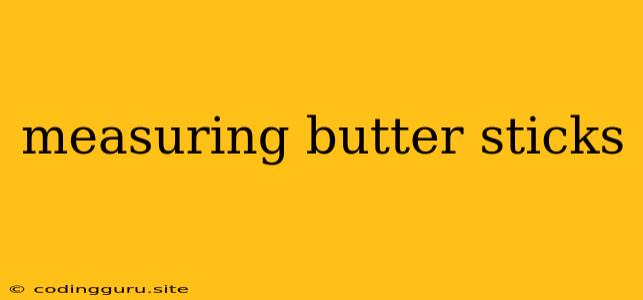Measuring Butter Sticks: A Guide to Achieving Perfect Baking Results
Butter, that golden delight that adds richness and flavor to our baked goods, can be a bit tricky to measure accurately. The standard "stick" of butter, weighing in at 113.4 grams (or 4 ounces), often leads to confusion when using measuring cups. This guide will help you navigate the world of butter sticks and ensure you're measuring precisely for perfect baking results.
Why is Measuring Butter Important?
Accurate measuring of butter is crucial for achieving consistent results in baking. Too much butter can make your cookies spread too thin or your cake dense, while too little can lead to dryness and a lack of flavor. The right amount of butter is essential for creating the perfect texture and taste in your recipes.
Understanding Butter Sticks and Their Measurements
- The Standard Butter Stick: A standard butter stick typically weighs 113.4 grams (or 4 ounces) and is divided into 8 equal sections. Each section represents 1 tablespoon of butter.
- Measurements:
- 1 Stick: 113.4 grams (4 ounces)
- 1/2 Stick: 56.7 grams (2 ounces)
- 1/4 Stick: 28.3 grams (1 ounce)
- 1/8 Stick: 14.2 grams (0.5 ounces)
Techniques for Measuring Butter Sticks
1. Using a Measuring Cup:
- Softened Butter: For recipes calling for softened butter, use a flexible measuring cup (silicone or plastic). Scoop the butter into the cup, pressing it down firmly with the back of a spoon or spatula to remove any air pockets.
- Cold Butter: For recipes requiring cold butter, use a measuring cup with a straight edge. Cut cold butter into small pieces and gently press them into the cup until the butter reaches the top.
2. Using a Kitchen Scale:
- Most Accurate Method: A kitchen scale offers the most precise way to measure butter. Simply weigh the desired amount of butter.
- Easy Conversion: For example, if a recipe calls for 1/2 cup (1 stick) of butter, simply weigh out 113.4 grams.
3. Using a Butter Knife:
- For Smaller Amounts: When measuring small quantities of butter, such as 1/8 stick, use a butter knife to carefully cut the desired amount from a butter stick.
- Divide Evenly: Visually divide the stick into eighths and use the knife to cut along the marked lines.
Tips for Measuring Butter Sticks
- Soften Butter Properly: For recipes requiring softened butter, it's important to soften it correctly. Use a microwave in short bursts, or leave it at room temperature for a few hours until it is pliable and easily spreads.
- Don't Overcrowd the Cup: Don't overfill your measuring cup when measuring butter. This can result in an inaccurate measurement and affect your recipe.
- Clean the Measuring Cup: Make sure to clean your measuring cup thoroughly after each use to avoid any residue that can affect your future measurements.
Common Mistakes to Avoid When Measuring Butter
- Using the Wrong Measuring Cup: Using a rigid measuring cup for softened butter can lead to inaccurate measurements.
- Not Pressing Down Firmly: Failure to press down firmly on butter when using a measuring cup can result in air pockets and an inaccurate measurement.
- Ignoring Butter Temperature: Using cold butter for a recipe requiring softened butter can cause the butter to clump and not incorporate properly into your mixture.
Conclusion
Mastering the art of measuring butter sticks is essential for achieving perfect baking results. By understanding the different techniques, tips, and common mistakes, you can ensure your baking adventures are filled with delicious and consistent outcomes. Whether you prefer using a measuring cup, kitchen scale, or a butter knife, the key is to be precise and consistent in your measurement process. So, grab your butter sticks, follow these guidelines, and let your baking journey be filled with success and joy!
